

Doing well and doing good by doing art: The effects of education in the visual and performing arts on the achievements and values of young adults. Abstract: This study is based on the researcher’s prior work analyzing data from the National Educational Longitudinal Survey (NELS:88), a data set of information on approximately 25,000 secondary school students over four years, in which he found significant connections between involvement in arts learning and general academic success.
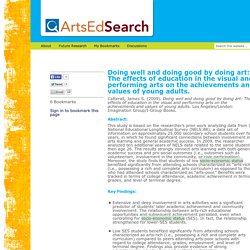
In 2009, the researcher analyzed ten additional years of NELS data related to the same students, then age 26. The results strongly connect arts learning with both general academic success and pro-social outcomes (i.e., outcomes such as volunteerism, involvement in the community, or civic participation). Moreover, the study finds that students of low socio-economic status benefited significantly from attending schools characterized as “arts-rich” (i.e., possessing a rich and complete arts curriculum) as opposed to those who had attended schools characterized as “arts-poor.”
Key Findings: Significance of the Findings: Methodology: Limitations of the Research: Educators Reference Complete - Document. But That's Just Good Teaching! The Case for Culturally Relevant Pedagogy.: EBSCOhost. media.proquest.com.pearl.stkate.edu/media/pq/classic/doc/2724916521/fmt/pi/rep/NONE?hl=teachers%2Cteacher%2Cteachers%2Cteacher%2Cidentity%2Cidentities%2Cidentity%2Cidentities%2Cthe%2Cthe%2Cfingerprints%2Cfingerprint%2Cfingerprints%2Cfingerprint%2Cof%2Cof.
media.proquest.com.pearl.stkate.edu/media/pq/classic/doc/2265359011/fmt/pi/rep/NONE?hl=culturally%2Cculturally%2Crelevant%2Crelevant%2Cpedagogies%2Cpedagogy%2Cpedagogies%2Cpedagogy%2Cin%2Cin%2Ca%2Ca%2Cdiverse%2Cdiverse%2Curban%2Curban%2Cclassrooms%2Cclas. Strengthening Student Engagement:A Framework for Culturally Responsive Teaching.
media.proquest.com.pearl.stkate.edu/media/pq/classic/doc/1291372411/fmt/pi/rep/NONE?hl=natives%2Cnative%2Cnatives%2Cnative%2Camericans%2Camerican%2Camericans%2Camerican%2Ceducation%2Ceducation%2Chigher%2Chighest%2Chighs%2Chigh%2Chigher%2Chighest%2Chighs% Unpacking the Placement of American Indian and Alaska Native Students in Special Education Programs and Services in the Early Grades: School Readiness as a Predictive Variable - ProQuest Education Journals - ProQuest. 1819-2013: A History of American Indian Education - Education Week. www.google.com/url?sa=t&rct=j&q=&esrc=s&source=web&cd=2&ved=0CDcQFjAB&url=http%3A%2F%2Fwww.huffingtonpost.com%2Ftag%2Fnative-american-education&ei=uso9U7_0BZLE2QXvhYHgDg&usg=AFQjCNHPUg2osh0tP1oK02KvjNsJDpUDAg&bvm=bv.64125504,d.cWc.
National Indian Education Association. Graduation Rates Dropping Among Native American Students. Major gains among black and Latino students pushed the nation's high school graduation rates to near record levels.
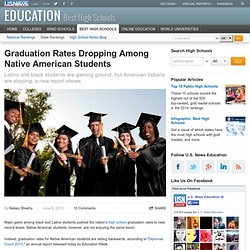
Native American students, however, are not enjoying the same boom. Instead, graduation rates for Native American students are sliding backwards, according to "Diplomas Count 2013," an annual report released today by Education Week. Roughly 51 percent of Native American students in the class of 2010 earned a high school diploma. That's down from 54 percent in 2008, when graduation rates for the group reached its peak. "What we're dealing with here is a tremendous issue," says RiShawn Biddle, director of communications for the National Indian Education Association. Part of the issue stems from American Indian students winding up in schools that are already "dropout factories," Biddle says.
"In many ways, our students are invisible," Biddle says. [Find out how sequester cuts affected Native American students.] www.pps.k12.or.us/files/tag/What_Do_Students_Need-Ch_6_Diane_Heacox-foundation_secondary. Untitled. Differentiating instruc. Teaching hist to support div learn. By: National Center for Technology Innovation and Center for Implementing Technology in Education (CITEd) (2007) Instruction focused on students engaged in historical thinking is fairly new in educational research.
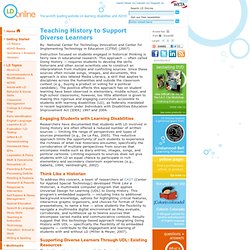
This approach — often called Doing History — requires students to develop the skills historians and other social scientists use to construct an interpretation from multiple and conflicting sources. Since these sources often include songs, images, and documents, this approach is also labeled Media Literacy, a skill that applies to disciplines across the humanities and outside the classroom context (e.g., buying a product or voting for a political candidate). Engaging Students with Learning Disabilities Researchers have documented that students with LD involved in Doing History are often offered a reduced number of written sources — limiting the range of perspectives and types of sources presented (e.g., De La Paz, 2005).
Think Like a Historian Establish a Purpose Evaluate Sources. Untitled. Untitled. Too dumb for complex text? Back in September 2008, some 3 million people in the United States became college freshmen—the largest cohort ever.
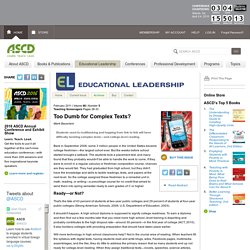
But the weeks before school started brought a setback. The students took a placement test, and many found that they probably wouldn't be able to handle the work to come. If they were to enroll in a regular calculus or freshman composition course, chances are they would fail. They had graduated from high school, but they didn't have the knowledge and skills to tackle readings, tests, and papers at the next level. So the college assigned these freshmen to a remedial unit in math, reading, or writing—a precollege course for no credit that aimed to send them into spring semester ready to earn grades of C or higher.
Ready—or Not? That's the fate of 43 percent of students at two-year public colleges and 29 percent of students at four-year public colleges (Strong American Schools, 2008; U.S. It shouldn't happen. Will more technology in high school classrooms help? References. Mn online tests. By Christopher Magancmagan@pioneerpress.com Posted: 11/15/2013 12:01:00 AM CST | Updated: 5 months ago Minnesota is moving ahead with plans to assess nearly every student's proficiency with online tests beginning in 2015, despite recent troubles with online tests.

State education leaders plan to ink deals by winter for online versions of the Minnesota Comprehensive Assessments, or MCAs, and new college and career readiness exams. The American Institutes for Research, or AIR, the state's current online test provider, was not among the four companies to bid on the two projects. Battle over cursive. By Julie Carr Smyth, Associated Press Posted: 11/14/2013 01:02:23 AM CST | Updated: 5 months ago The swirling lines from Linden Bateman's pen have been conscripted into a national fight to keep cursive writing in American classrooms.
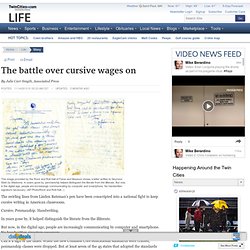
Cursive. Penmanship. Handwriting. In years gone by, it helped distinguish the literate from the illiterate. But now, in the digital age, people are increasingly communicating by computer and smartphone. Call it a sign of the times. Bateman, a 72-year-old state representative from Idaho, says cursive conveys intelligence and grace, engages creativity and builds brain cells. “Modern research indicates that more areas of the human brain are engaged when children use cursive handwriting than when they keyboard,” said Bateman, who handwrites 125 ornate letters each year.
States that adopted Common Core aren't precluded from deviating from the standards. “The Constitution of the United States is written in cursive. The volume of first-class mail at the U.S.
Tech. Units. Education Week American Education News Site of Record.